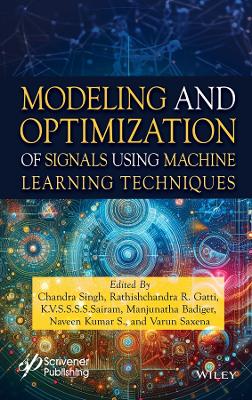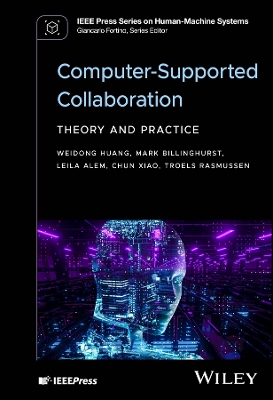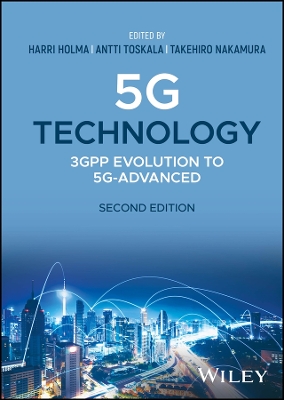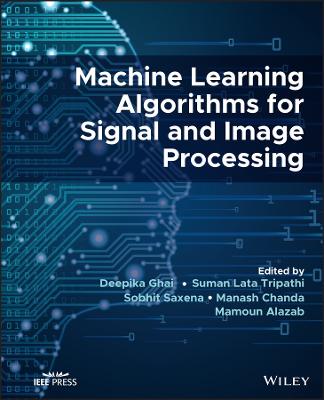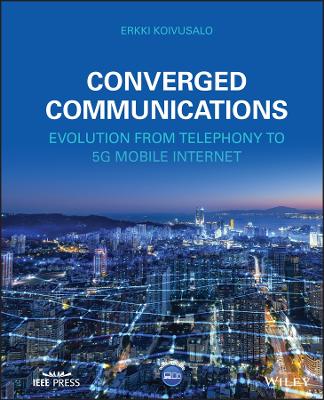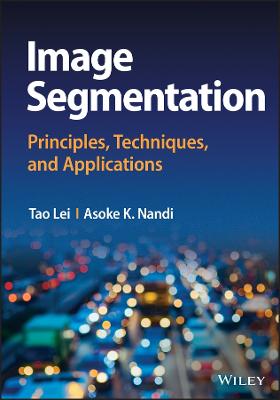Joint Communications and Sensing
 -15%
portes grátis
-15%
portes grátis
Joint Communications and Sensing
From Fundamentals to Advanced Techniques
Zhang, J. Andrew; Wu, Kai; Guo, Yingjie Jay
John Wiley & Sons Inc
11/2022
320
Dura
Inglês
9781119982913
15 a 20 dias
666
Descrição não disponível.
Acknowledgments xiii
Preface xv
Acronyms xvii
Part I Fundamentals of Joint Communications and
Sensing (JCAS) 1
1 Introduction to Joint Communications and Sensing
(JCAS) 3
1.1 Background 3
1.2 Three Categories of JCAS Systems 5
1.2.1 Major Differences Between Communications and Sensing 7
1.2.2 Communications-Centric Design 12
1.2.3 Radar-Centric Design 15
1.2.4 Joint Design without an Underlying System 17
1.2.5 Summary of Key Research Problems 18
1.3 Potential Sensing Applications of JCAS 18
1.4 Book Organization 22
References 24
2 Signal Processing Fundamentals for JCAS 31
2.1 Channel Model for Communications and Radar 31
2.2 Basic Communication Signals and Systems 33
2.2.1 Single-Carrier MIMO 33
2.2.2 MIMO-OFDM 34
2.2.3 Transmitter and Receiver Signal Processing in Communications 34
2.3 MIMO Radar Signals and Systems 36
2.3.1 Single-Carrier MIMO Radar 36
2.3.2 MIMO-OFDM Radar 37
2.3.3 FH-MIMO Radar 38
2.4 Basic Signal Processing for Radar Sensing 40
2.4.1 Matched Filtering 40
2.4.2 Moving Target Detection (MTD) 41
2.4.3 Spatial-Domain Processing 42
2.4.4 Target Detection 43
2.4.5 Spatial Refinement 44
2.5 Signal Processing Basics for Communication-Centric JCAS 44
2.5.1 802.11ad JCAS Systems 44
2.5.2 Mobile Network with JCAS Capabilities 46
2.5.3 Sensing Parameter Estimation 46
2.5.3.1 Direct and Indirect Sensing 47
2.5.3.2 Sensing Algorithms 49
2.6 Signal Processing Basics for DFRC 50
2.6.1 Embedding Information in RadarWaveform 50
2.6.2 Signal Reception and Processing for Communications 52
2.6.2.1 Demodulation 53
2.6.2.2 Channel Estimation 54
2.6.3 Codebook Design 54
2.7 Conclusions 55
References 55
3 Efficient Parameter Estimation 59
3.1 Q-Shifted Estimator (QSE) 60
3.2 Refined QSE (QSEr) 62
3.2.1 Impact ofq 62
3.2.2 Refined Optimalq 66
3.2.3 Numerical Illustration of QSEr 67
3.3 Pade approximation-Enabled Estimator 70
3.3.1 Core Updating Function 71
3.3.2 Initialization and Overall Estimation Procedure 74
3.3.3 Numerical Illustrations 76
3.4 Conclusions 80
References 80
Part II Communication-Centric JCAS 83
4 Perceptive Mobile Network (PMN) 85
4.1 Framework for PMN 85
4.1.1 System Platform and Infrastructure 86
Trim Size: 6in x 9in Single Column Wu982913 ftoc.tex V1 - 09/06/2022 5:13pm Page vii
[1]
[1] [1]
[1]
Contents vii
4.1.1.1 CRAN 87
4.1.1.2 Standalone BS 87
4.1.2 Three Types of Sensing Operations 88
4.1.2.1 Downlink Active Sensing 88
4.1.2.2 Downlink Passive Sensing 88
4.1.2.3 Uplink Sensing 89
4.1.2.4 Comparison 89
4.1.3 Signals Usable from 5G NR for Radio Sensing 90
4.1.3.1 Reference Signals Used for Channel Estimation 90
4.1.3.2 Nonchannel Estimation Signals 92
4.1.3.3 Data Payload Signals 92
4.2 System Modifications to Enable Sensing 92
4.2.1 Dedicated Transmitter for Uplink Sensing 93
4.2.2 Dedicated Receiver for Downlink (and Uplink) Sensing 94
4.2.3 Full-Duplex Radios for Downlink Sensing 94
4.2.4 Base Stations with Widely Separated Transmitting and Receiving
Antennas 96
4.3 System Issues 98
4.3.1 Performance Bounds 98
4.3.2 Waveform Optimization 100
4.3.2.1 Spatial Optimization 102
4.3.2.2 Optimization in Time and Frequency Domains 105
4.3.2.3 Optimization with Next-Generation Signaling Formats 106
4.3.3 Antenna Array Design 106
4.3.3.1 Virtual MIMO and Antenna Grouping 107
4.3.3.2 Sparse Array Design 108
4.3.3.3 Spatial Modulation 109
4.3.3.4 Reconfigurable Intelligent Surface-Assisted JCAS 109
4.3.4 Clutter Suppression Techniques 110
4.3.4.1 Recursive Moving Averaging (RMA) 112
4.3.4.2 Gaussian Mixture Model (GMM) 113
4.3.5 Sensing Parameter Estimation 114
4.3.5.1 Periodogram such as 2D DFT 115
4.3.5.2 Subspace-Based Spectrum Analysis Techniques 115
4.3.5.3 On-Grid Compressive Sensing Algorithms 117
4.3.6 Resolution of Sensing Ambiguity 119
4.3.7 Pattern Analysis 122
4.3.8 Networked Sensing under Cellular Topology 123
4.3.8.1 Fundamental Theories and Performance Bounds for "Cellular Sensing
Networks" 123
4.3.8.2 Distributed Sensing with Node Grouping and Cooperation 124
4.3.9 Sensing-Assisted Communications 124
4.3.9.1 Sensing-Assisted Beamforming 124
4.3.9.2 Sensing-Assisted Secure Communications 128
4.4 Conclusions 128
References 128
5 Integrating Low-Complexity and Flexible Sensing into
Communication Systems: A Unified Sensing
Framework 139
5.1 Problem Statement and Signal Model 139
5.1.1 Signal Model 140
5.1.2 Classical OFDM Sensing (COS) 142
5.1.3 Problem Statement 143
5.1.3.1 CP-limited Sensing Distance 143
5.1.3.2 Communication-limited Velocity measurement 143
5.1.3.3 COS adapted for DFT-S-OFDM 144
5.2 A Low-Complexity Sensing Framework 144
5.3 Performance Analysis 150
5.3.1 Preliminary Results 150
5.3.2 Analyzing Signal Components in Two RDMs 151
5.3.3 Comparison and Insights 154
5.3.4 Criteria for Setting Key Sensing Parameters 157
5.4 Simulation Results 158
5.4.1 Illustrating SINRs in RDMs 159
5.4.2 Illustration of Target Detection 162
5.5 Conclusions 166
References 167
6 Sensing Framework Optimization 169
6.1 Echo Preprocessing 169
6.1.1 Reshaping 170
6.1.2 Virtual Cyclic Prefix (VCP) 171
6.1.3 Removing Communication Information 174
6.2 Target Parameter Estimation 177
6.2.1 Parameter Estimation Method 177
6.2.2 Computational Complexity 181
6.3 Optimizing Parameters of Sensing Methods 182
6.3.1 Preliminary Results 183
6.3.2 Maximizing SINR for Parameter Estimation 184
6.4 Simulation Results 186
6.4.1 Comparison with Benchmark Method 186
Trim Size: 6in x 9in Single Column Wu982913 ftoc.tex V1 - 09/06/2022 5:13pm Page ix
[1]
[1] [1]
[1]
Contents ix
6.4.2 Wide Applicability 189
6.5 Conclusions 192
References 193
Part III Radar-Centric Joint Communications and
Sensing 195
7 FH-MIMO Dual-Function Radar-Based Communications:
Single-Antenna Receiver 197
7.1 Problem Statement 198
7.2 Waveform Design for FH-MIMO DFRC 199
7.2.1 FH-MIMO RadarWaveform 200
7.2.2 Overall Channel Estimation Scheme 202
7.2.2.1 Estimate Timing Offset 203
7.2.2.2 Estimate Channel Parameters 203
7.3 Estimating Timing Offset 203
7.3.1 Two Estimation Methods 204
7.3.2 Performance Analysis and Comparison of the Estimators 205
7.3.3 Design of a Suboptimal Hopping Frequency Sequence 208
7.4 Estimating Channel Response 209
7.4.1 Estimation Method 209
7.4.2 Complexity Analysis 210
7.5 Using Estimations in Data Communications 211
7.6 Extensions to Multipath Cases 212
7.7 Simulation Results 214
7.8 Conclusions 219
References 219
8 Frequency-Hopping MIMO Radar-Based Communications
with Multiantenna Receiver 221
8.1 Signal Model 221
8.2 The DFRC Signal Mode 223
8.3 A Multiantenna Receiving Scheme 226
8.3.1 Estimating Channel Response 226
8.3.2 Estimating Timing Offset 227
8.3.2.1 Estimating L?? 228
8.3.2.2 Removing Estimation Ambiguity 229
8.3.3 Information Demodulation 230
8.3.3.1 Estimating khm 230
8.3.3.2 FHCS Demodulation 232
8.3.3.3 PSK Demodulation 232
8.4 Performance Analysis 232
8.4.1 Performance of Channel Coefficient Estimation 232
8.4.2 Performance of Timing Offset Estimation 233
8.4.3 Communication Performance 234
8.4.3.1 Achievable Rate 234
8.4.3.2 SER of PSK-Based FH-MIMO DFRC 234
8.5 Simulations 235
8.6 Conclusions 240
References 240
9 Integrating Secure Communications into Frequency Hopping
MIMO Radar with Improved Data Rates 243
9.1 Signal Models and Overall Design 243
9.1.1 Signal Model of Bob 244
9.1.2 Signal Model of Eve 245
9.1.3 Overall Description 246
9.1.4 Maximum Achievable Rate (MAR) 247
9.2 Elementwise Phase Compensation 249
9.2.1 AoD-Dependence Issue of Hopping Frequency Permutation Selection
(HFPS) Demodulation 249
9.2.2 Elementwise phase compensation and HFPS Demodulation at
Bob 250
9.2.3 Enhancing Physical-Layer Security by Elementwise Phase
Compensation 252
9.3 Random Sign Reversal 253
9.3.1 Random Sign Reversal and Maximum Likelihood (ML)
Decoding 253
9.3.2 Detecting Random Sign Reversal at Bob 254
9.3.3 Random Sign Reversal Impact Analysis 255
9.3.4 Impact of Presented Design on Radar Performance 258
9.3.4.1 Impact of HFCS on R(??) 258
9.3.4.2 Impact of HFPS on R(??) 259
9.3.4.3 Impact of Elementwise Phase Compensation and Random Sign
Reversal on R(??) 259
9.3.4.4 Limitations of Presented Design for Radar Applications 260
9.3.5 Extension to Multipath and Multiuser Scenarios 260
9.3.5.1 Multipath Scenario 260
9.3.5.2 Multiuser Scenario 261
9.4 Simulation Results 261
9.5 Conclusions 267
References 267
Trim Size: 6in x 9in Single Column Wu982913 ftoc.tex V1 - 09/06/2022 5:13pm Page xi
[1]
[1] [1]
[1]
Contents xi
A Proofs, Analyses, and Derivations 271
A.1 Proof of Lemma 5.1 271
A.2 Proof of Lemma 5.2 271
A.3 Proof of Lemma 5.3 272
A.4 Proof of Proposition 5.1 273
A.5 Proof of Proposition 5.2 274
A.6 Proof of Proposition 6.1 275
A.7 Deriving the Powers of the Four Terms of X? n[l] Given in (6.33) 277
A.8 Proof of Proposition 6.2 280
A.9 Proof of Proposition 6.3 281
A.10 Deriving (9.31) 282
References 283
Index 285
Preface xv
Acronyms xvii
Part I Fundamentals of Joint Communications and
Sensing (JCAS) 1
1 Introduction to Joint Communications and Sensing
(JCAS) 3
1.1 Background 3
1.2 Three Categories of JCAS Systems 5
1.2.1 Major Differences Between Communications and Sensing 7
1.2.2 Communications-Centric Design 12
1.2.3 Radar-Centric Design 15
1.2.4 Joint Design without an Underlying System 17
1.2.5 Summary of Key Research Problems 18
1.3 Potential Sensing Applications of JCAS 18
1.4 Book Organization 22
References 24
2 Signal Processing Fundamentals for JCAS 31
2.1 Channel Model for Communications and Radar 31
2.2 Basic Communication Signals and Systems 33
2.2.1 Single-Carrier MIMO 33
2.2.2 MIMO-OFDM 34
2.2.3 Transmitter and Receiver Signal Processing in Communications 34
2.3 MIMO Radar Signals and Systems 36
2.3.1 Single-Carrier MIMO Radar 36
2.3.2 MIMO-OFDM Radar 37
2.3.3 FH-MIMO Radar 38
2.4 Basic Signal Processing for Radar Sensing 40
2.4.1 Matched Filtering 40
2.4.2 Moving Target Detection (MTD) 41
2.4.3 Spatial-Domain Processing 42
2.4.4 Target Detection 43
2.4.5 Spatial Refinement 44
2.5 Signal Processing Basics for Communication-Centric JCAS 44
2.5.1 802.11ad JCAS Systems 44
2.5.2 Mobile Network with JCAS Capabilities 46
2.5.3 Sensing Parameter Estimation 46
2.5.3.1 Direct and Indirect Sensing 47
2.5.3.2 Sensing Algorithms 49
2.6 Signal Processing Basics for DFRC 50
2.6.1 Embedding Information in RadarWaveform 50
2.6.2 Signal Reception and Processing for Communications 52
2.6.2.1 Demodulation 53
2.6.2.2 Channel Estimation 54
2.6.3 Codebook Design 54
2.7 Conclusions 55
References 55
3 Efficient Parameter Estimation 59
3.1 Q-Shifted Estimator (QSE) 60
3.2 Refined QSE (QSEr) 62
3.2.1 Impact ofq 62
3.2.2 Refined Optimalq 66
3.2.3 Numerical Illustration of QSEr 67
3.3 Pade approximation-Enabled Estimator 70
3.3.1 Core Updating Function 71
3.3.2 Initialization and Overall Estimation Procedure 74
3.3.3 Numerical Illustrations 76
3.4 Conclusions 80
References 80
Part II Communication-Centric JCAS 83
4 Perceptive Mobile Network (PMN) 85
4.1 Framework for PMN 85
4.1.1 System Platform and Infrastructure 86
Trim Size: 6in x 9in Single Column Wu982913 ftoc.tex V1 - 09/06/2022 5:13pm Page vii
[1]
[1] [1]
[1]
Contents vii
4.1.1.1 CRAN 87
4.1.1.2 Standalone BS 87
4.1.2 Three Types of Sensing Operations 88
4.1.2.1 Downlink Active Sensing 88
4.1.2.2 Downlink Passive Sensing 88
4.1.2.3 Uplink Sensing 89
4.1.2.4 Comparison 89
4.1.3 Signals Usable from 5G NR for Radio Sensing 90
4.1.3.1 Reference Signals Used for Channel Estimation 90
4.1.3.2 Nonchannel Estimation Signals 92
4.1.3.3 Data Payload Signals 92
4.2 System Modifications to Enable Sensing 92
4.2.1 Dedicated Transmitter for Uplink Sensing 93
4.2.2 Dedicated Receiver for Downlink (and Uplink) Sensing 94
4.2.3 Full-Duplex Radios for Downlink Sensing 94
4.2.4 Base Stations with Widely Separated Transmitting and Receiving
Antennas 96
4.3 System Issues 98
4.3.1 Performance Bounds 98
4.3.2 Waveform Optimization 100
4.3.2.1 Spatial Optimization 102
4.3.2.2 Optimization in Time and Frequency Domains 105
4.3.2.3 Optimization with Next-Generation Signaling Formats 106
4.3.3 Antenna Array Design 106
4.3.3.1 Virtual MIMO and Antenna Grouping 107
4.3.3.2 Sparse Array Design 108
4.3.3.3 Spatial Modulation 109
4.3.3.4 Reconfigurable Intelligent Surface-Assisted JCAS 109
4.3.4 Clutter Suppression Techniques 110
4.3.4.1 Recursive Moving Averaging (RMA) 112
4.3.4.2 Gaussian Mixture Model (GMM) 113
4.3.5 Sensing Parameter Estimation 114
4.3.5.1 Periodogram such as 2D DFT 115
4.3.5.2 Subspace-Based Spectrum Analysis Techniques 115
4.3.5.3 On-Grid Compressive Sensing Algorithms 117
4.3.6 Resolution of Sensing Ambiguity 119
4.3.7 Pattern Analysis 122
4.3.8 Networked Sensing under Cellular Topology 123
4.3.8.1 Fundamental Theories and Performance Bounds for "Cellular Sensing
Networks" 123
4.3.8.2 Distributed Sensing with Node Grouping and Cooperation 124
4.3.9 Sensing-Assisted Communications 124
4.3.9.1 Sensing-Assisted Beamforming 124
4.3.9.2 Sensing-Assisted Secure Communications 128
4.4 Conclusions 128
References 128
5 Integrating Low-Complexity and Flexible Sensing into
Communication Systems: A Unified Sensing
Framework 139
5.1 Problem Statement and Signal Model 139
5.1.1 Signal Model 140
5.1.2 Classical OFDM Sensing (COS) 142
5.1.3 Problem Statement 143
5.1.3.1 CP-limited Sensing Distance 143
5.1.3.2 Communication-limited Velocity measurement 143
5.1.3.3 COS adapted for DFT-S-OFDM 144
5.2 A Low-Complexity Sensing Framework 144
5.3 Performance Analysis 150
5.3.1 Preliminary Results 150
5.3.2 Analyzing Signal Components in Two RDMs 151
5.3.3 Comparison and Insights 154
5.3.4 Criteria for Setting Key Sensing Parameters 157
5.4 Simulation Results 158
5.4.1 Illustrating SINRs in RDMs 159
5.4.2 Illustration of Target Detection 162
5.5 Conclusions 166
References 167
6 Sensing Framework Optimization 169
6.1 Echo Preprocessing 169
6.1.1 Reshaping 170
6.1.2 Virtual Cyclic Prefix (VCP) 171
6.1.3 Removing Communication Information 174
6.2 Target Parameter Estimation 177
6.2.1 Parameter Estimation Method 177
6.2.2 Computational Complexity 181
6.3 Optimizing Parameters of Sensing Methods 182
6.3.1 Preliminary Results 183
6.3.2 Maximizing SINR for Parameter Estimation 184
6.4 Simulation Results 186
6.4.1 Comparison with Benchmark Method 186
Trim Size: 6in x 9in Single Column Wu982913 ftoc.tex V1 - 09/06/2022 5:13pm Page ix
[1]
[1] [1]
[1]
Contents ix
6.4.2 Wide Applicability 189
6.5 Conclusions 192
References 193
Part III Radar-Centric Joint Communications and
Sensing 195
7 FH-MIMO Dual-Function Radar-Based Communications:
Single-Antenna Receiver 197
7.1 Problem Statement 198
7.2 Waveform Design for FH-MIMO DFRC 199
7.2.1 FH-MIMO RadarWaveform 200
7.2.2 Overall Channel Estimation Scheme 202
7.2.2.1 Estimate Timing Offset 203
7.2.2.2 Estimate Channel Parameters 203
7.3 Estimating Timing Offset 203
7.3.1 Two Estimation Methods 204
7.3.2 Performance Analysis and Comparison of the Estimators 205
7.3.3 Design of a Suboptimal Hopping Frequency Sequence 208
7.4 Estimating Channel Response 209
7.4.1 Estimation Method 209
7.4.2 Complexity Analysis 210
7.5 Using Estimations in Data Communications 211
7.6 Extensions to Multipath Cases 212
7.7 Simulation Results 214
7.8 Conclusions 219
References 219
8 Frequency-Hopping MIMO Radar-Based Communications
with Multiantenna Receiver 221
8.1 Signal Model 221
8.2 The DFRC Signal Mode 223
8.3 A Multiantenna Receiving Scheme 226
8.3.1 Estimating Channel Response 226
8.3.2 Estimating Timing Offset 227
8.3.2.1 Estimating L?? 228
8.3.2.2 Removing Estimation Ambiguity 229
8.3.3 Information Demodulation 230
8.3.3.1 Estimating khm 230
8.3.3.2 FHCS Demodulation 232
8.3.3.3 PSK Demodulation 232
8.4 Performance Analysis 232
8.4.1 Performance of Channel Coefficient Estimation 232
8.4.2 Performance of Timing Offset Estimation 233
8.4.3 Communication Performance 234
8.4.3.1 Achievable Rate 234
8.4.3.2 SER of PSK-Based FH-MIMO DFRC 234
8.5 Simulations 235
8.6 Conclusions 240
References 240
9 Integrating Secure Communications into Frequency Hopping
MIMO Radar with Improved Data Rates 243
9.1 Signal Models and Overall Design 243
9.1.1 Signal Model of Bob 244
9.1.2 Signal Model of Eve 245
9.1.3 Overall Description 246
9.1.4 Maximum Achievable Rate (MAR) 247
9.2 Elementwise Phase Compensation 249
9.2.1 AoD-Dependence Issue of Hopping Frequency Permutation Selection
(HFPS) Demodulation 249
9.2.2 Elementwise phase compensation and HFPS Demodulation at
Bob 250
9.2.3 Enhancing Physical-Layer Security by Elementwise Phase
Compensation 252
9.3 Random Sign Reversal 253
9.3.1 Random Sign Reversal and Maximum Likelihood (ML)
Decoding 253
9.3.2 Detecting Random Sign Reversal at Bob 254
9.3.3 Random Sign Reversal Impact Analysis 255
9.3.4 Impact of Presented Design on Radar Performance 258
9.3.4.1 Impact of HFCS on R(??) 258
9.3.4.2 Impact of HFPS on R(??) 259
9.3.4.3 Impact of Elementwise Phase Compensation and Random Sign
Reversal on R(??) 259
9.3.4.4 Limitations of Presented Design for Radar Applications 260
9.3.5 Extension to Multipath and Multiuser Scenarios 260
9.3.5.1 Multipath Scenario 260
9.3.5.2 Multiuser Scenario 261
9.4 Simulation Results 261
9.5 Conclusions 267
References 267
Trim Size: 6in x 9in Single Column Wu982913 ftoc.tex V1 - 09/06/2022 5:13pm Page xi
[1]
[1] [1]
[1]
Contents xi
A Proofs, Analyses, and Derivations 271
A.1 Proof of Lemma 5.1 271
A.2 Proof of Lemma 5.2 271
A.3 Proof of Lemma 5.3 272
A.4 Proof of Proposition 5.1 273
A.5 Proof of Proposition 5.2 274
A.6 Proof of Proposition 6.1 275
A.7 Deriving the Powers of the Four Terms of X? n[l] Given in (6.33) 277
A.8 Proof of Proposition 6.2 280
A.9 Proof of Proposition 6.3 281
A.10 Deriving (9.31) 282
References 283
Index 285
Este título pertence ao(s) assunto(s) indicados(s). Para ver outros títulos clique no assunto desejado.
Integrated sensing and communications; dualfunctional radar communications; mobile networks; frequency hopping; sensing parameter estimation; waveform optimization; radar; security; joint radar-communications; sensing
Acknowledgments xiii
Preface xv
Acronyms xvii
Part I Fundamentals of Joint Communications and
Sensing (JCAS) 1
1 Introduction to Joint Communications and Sensing
(JCAS) 3
1.1 Background 3
1.2 Three Categories of JCAS Systems 5
1.2.1 Major Differences Between Communications and Sensing 7
1.2.2 Communications-Centric Design 12
1.2.3 Radar-Centric Design 15
1.2.4 Joint Design without an Underlying System 17
1.2.5 Summary of Key Research Problems 18
1.3 Potential Sensing Applications of JCAS 18
1.4 Book Organization 22
References 24
2 Signal Processing Fundamentals for JCAS 31
2.1 Channel Model for Communications and Radar 31
2.2 Basic Communication Signals and Systems 33
2.2.1 Single-Carrier MIMO 33
2.2.2 MIMO-OFDM 34
2.2.3 Transmitter and Receiver Signal Processing in Communications 34
2.3 MIMO Radar Signals and Systems 36
2.3.1 Single-Carrier MIMO Radar 36
2.3.2 MIMO-OFDM Radar 37
2.3.3 FH-MIMO Radar 38
2.4 Basic Signal Processing for Radar Sensing 40
2.4.1 Matched Filtering 40
2.4.2 Moving Target Detection (MTD) 41
2.4.3 Spatial-Domain Processing 42
2.4.4 Target Detection 43
2.4.5 Spatial Refinement 44
2.5 Signal Processing Basics for Communication-Centric JCAS 44
2.5.1 802.11ad JCAS Systems 44
2.5.2 Mobile Network with JCAS Capabilities 46
2.5.3 Sensing Parameter Estimation 46
2.5.3.1 Direct and Indirect Sensing 47
2.5.3.2 Sensing Algorithms 49
2.6 Signal Processing Basics for DFRC 50
2.6.1 Embedding Information in RadarWaveform 50
2.6.2 Signal Reception and Processing for Communications 52
2.6.2.1 Demodulation 53
2.6.2.2 Channel Estimation 54
2.6.3 Codebook Design 54
2.7 Conclusions 55
References 55
3 Efficient Parameter Estimation 59
3.1 Q-Shifted Estimator (QSE) 60
3.2 Refined QSE (QSEr) 62
3.2.1 Impact ofq 62
3.2.2 Refined Optimalq 66
3.2.3 Numerical Illustration of QSEr 67
3.3 Pade approximation-Enabled Estimator 70
3.3.1 Core Updating Function 71
3.3.2 Initialization and Overall Estimation Procedure 74
3.3.3 Numerical Illustrations 76
3.4 Conclusions 80
References 80
Part II Communication-Centric JCAS 83
4 Perceptive Mobile Network (PMN) 85
4.1 Framework for PMN 85
4.1.1 System Platform and Infrastructure 86
Trim Size: 6in x 9in Single Column Wu982913 ftoc.tex V1 - 09/06/2022 5:13pm Page vii
[1]
[1] [1]
[1]
Contents vii
4.1.1.1 CRAN 87
4.1.1.2 Standalone BS 87
4.1.2 Three Types of Sensing Operations 88
4.1.2.1 Downlink Active Sensing 88
4.1.2.2 Downlink Passive Sensing 88
4.1.2.3 Uplink Sensing 89
4.1.2.4 Comparison 89
4.1.3 Signals Usable from 5G NR for Radio Sensing 90
4.1.3.1 Reference Signals Used for Channel Estimation 90
4.1.3.2 Nonchannel Estimation Signals 92
4.1.3.3 Data Payload Signals 92
4.2 System Modifications to Enable Sensing 92
4.2.1 Dedicated Transmitter for Uplink Sensing 93
4.2.2 Dedicated Receiver for Downlink (and Uplink) Sensing 94
4.2.3 Full-Duplex Radios for Downlink Sensing 94
4.2.4 Base Stations with Widely Separated Transmitting and Receiving
Antennas 96
4.3 System Issues 98
4.3.1 Performance Bounds 98
4.3.2 Waveform Optimization 100
4.3.2.1 Spatial Optimization 102
4.3.2.2 Optimization in Time and Frequency Domains 105
4.3.2.3 Optimization with Next-Generation Signaling Formats 106
4.3.3 Antenna Array Design 106
4.3.3.1 Virtual MIMO and Antenna Grouping 107
4.3.3.2 Sparse Array Design 108
4.3.3.3 Spatial Modulation 109
4.3.3.4 Reconfigurable Intelligent Surface-Assisted JCAS 109
4.3.4 Clutter Suppression Techniques 110
4.3.4.1 Recursive Moving Averaging (RMA) 112
4.3.4.2 Gaussian Mixture Model (GMM) 113
4.3.5 Sensing Parameter Estimation 114
4.3.5.1 Periodogram such as 2D DFT 115
4.3.5.2 Subspace-Based Spectrum Analysis Techniques 115
4.3.5.3 On-Grid Compressive Sensing Algorithms 117
4.3.6 Resolution of Sensing Ambiguity 119
4.3.7 Pattern Analysis 122
4.3.8 Networked Sensing under Cellular Topology 123
4.3.8.1 Fundamental Theories and Performance Bounds for "Cellular Sensing
Networks" 123
4.3.8.2 Distributed Sensing with Node Grouping and Cooperation 124
4.3.9 Sensing-Assisted Communications 124
4.3.9.1 Sensing-Assisted Beamforming 124
4.3.9.2 Sensing-Assisted Secure Communications 128
4.4 Conclusions 128
References 128
5 Integrating Low-Complexity and Flexible Sensing into
Communication Systems: A Unified Sensing
Framework 139
5.1 Problem Statement and Signal Model 139
5.1.1 Signal Model 140
5.1.2 Classical OFDM Sensing (COS) 142
5.1.3 Problem Statement 143
5.1.3.1 CP-limited Sensing Distance 143
5.1.3.2 Communication-limited Velocity measurement 143
5.1.3.3 COS adapted for DFT-S-OFDM 144
5.2 A Low-Complexity Sensing Framework 144
5.3 Performance Analysis 150
5.3.1 Preliminary Results 150
5.3.2 Analyzing Signal Components in Two RDMs 151
5.3.3 Comparison and Insights 154
5.3.4 Criteria for Setting Key Sensing Parameters 157
5.4 Simulation Results 158
5.4.1 Illustrating SINRs in RDMs 159
5.4.2 Illustration of Target Detection 162
5.5 Conclusions 166
References 167
6 Sensing Framework Optimization 169
6.1 Echo Preprocessing 169
6.1.1 Reshaping 170
6.1.2 Virtual Cyclic Prefix (VCP) 171
6.1.3 Removing Communication Information 174
6.2 Target Parameter Estimation 177
6.2.1 Parameter Estimation Method 177
6.2.2 Computational Complexity 181
6.3 Optimizing Parameters of Sensing Methods 182
6.3.1 Preliminary Results 183
6.3.2 Maximizing SINR for Parameter Estimation 184
6.4 Simulation Results 186
6.4.1 Comparison with Benchmark Method 186
Trim Size: 6in x 9in Single Column Wu982913 ftoc.tex V1 - 09/06/2022 5:13pm Page ix
[1]
[1] [1]
[1]
Contents ix
6.4.2 Wide Applicability 189
6.5 Conclusions 192
References 193
Part III Radar-Centric Joint Communications and
Sensing 195
7 FH-MIMO Dual-Function Radar-Based Communications:
Single-Antenna Receiver 197
7.1 Problem Statement 198
7.2 Waveform Design for FH-MIMO DFRC 199
7.2.1 FH-MIMO RadarWaveform 200
7.2.2 Overall Channel Estimation Scheme 202
7.2.2.1 Estimate Timing Offset 203
7.2.2.2 Estimate Channel Parameters 203
7.3 Estimating Timing Offset 203
7.3.1 Two Estimation Methods 204
7.3.2 Performance Analysis and Comparison of the Estimators 205
7.3.3 Design of a Suboptimal Hopping Frequency Sequence 208
7.4 Estimating Channel Response 209
7.4.1 Estimation Method 209
7.4.2 Complexity Analysis 210
7.5 Using Estimations in Data Communications 211
7.6 Extensions to Multipath Cases 212
7.7 Simulation Results 214
7.8 Conclusions 219
References 219
8 Frequency-Hopping MIMO Radar-Based Communications
with Multiantenna Receiver 221
8.1 Signal Model 221
8.2 The DFRC Signal Mode 223
8.3 A Multiantenna Receiving Scheme 226
8.3.1 Estimating Channel Response 226
8.3.2 Estimating Timing Offset 227
8.3.2.1 Estimating L?? 228
8.3.2.2 Removing Estimation Ambiguity 229
8.3.3 Information Demodulation 230
8.3.3.1 Estimating khm 230
8.3.3.2 FHCS Demodulation 232
8.3.3.3 PSK Demodulation 232
8.4 Performance Analysis 232
8.4.1 Performance of Channel Coefficient Estimation 232
8.4.2 Performance of Timing Offset Estimation 233
8.4.3 Communication Performance 234
8.4.3.1 Achievable Rate 234
8.4.3.2 SER of PSK-Based FH-MIMO DFRC 234
8.5 Simulations 235
8.6 Conclusions 240
References 240
9 Integrating Secure Communications into Frequency Hopping
MIMO Radar with Improved Data Rates 243
9.1 Signal Models and Overall Design 243
9.1.1 Signal Model of Bob 244
9.1.2 Signal Model of Eve 245
9.1.3 Overall Description 246
9.1.4 Maximum Achievable Rate (MAR) 247
9.2 Elementwise Phase Compensation 249
9.2.1 AoD-Dependence Issue of Hopping Frequency Permutation Selection
(HFPS) Demodulation 249
9.2.2 Elementwise phase compensation and HFPS Demodulation at
Bob 250
9.2.3 Enhancing Physical-Layer Security by Elementwise Phase
Compensation 252
9.3 Random Sign Reversal 253
9.3.1 Random Sign Reversal and Maximum Likelihood (ML)
Decoding 253
9.3.2 Detecting Random Sign Reversal at Bob 254
9.3.3 Random Sign Reversal Impact Analysis 255
9.3.4 Impact of Presented Design on Radar Performance 258
9.3.4.1 Impact of HFCS on R(??) 258
9.3.4.2 Impact of HFPS on R(??) 259
9.3.4.3 Impact of Elementwise Phase Compensation and Random Sign
Reversal on R(??) 259
9.3.4.4 Limitations of Presented Design for Radar Applications 260
9.3.5 Extension to Multipath and Multiuser Scenarios 260
9.3.5.1 Multipath Scenario 260
9.3.5.2 Multiuser Scenario 261
9.4 Simulation Results 261
9.5 Conclusions 267
References 267
Trim Size: 6in x 9in Single Column Wu982913 ftoc.tex V1 - 09/06/2022 5:13pm Page xi
[1]
[1] [1]
[1]
Contents xi
A Proofs, Analyses, and Derivations 271
A.1 Proof of Lemma 5.1 271
A.2 Proof of Lemma 5.2 271
A.3 Proof of Lemma 5.3 272
A.4 Proof of Proposition 5.1 273
A.5 Proof of Proposition 5.2 274
A.6 Proof of Proposition 6.1 275
A.7 Deriving the Powers of the Four Terms of X? n[l] Given in (6.33) 277
A.8 Proof of Proposition 6.2 280
A.9 Proof of Proposition 6.3 281
A.10 Deriving (9.31) 282
References 283
Index 285
Preface xv
Acronyms xvii
Part I Fundamentals of Joint Communications and
Sensing (JCAS) 1
1 Introduction to Joint Communications and Sensing
(JCAS) 3
1.1 Background 3
1.2 Three Categories of JCAS Systems 5
1.2.1 Major Differences Between Communications and Sensing 7
1.2.2 Communications-Centric Design 12
1.2.3 Radar-Centric Design 15
1.2.4 Joint Design without an Underlying System 17
1.2.5 Summary of Key Research Problems 18
1.3 Potential Sensing Applications of JCAS 18
1.4 Book Organization 22
References 24
2 Signal Processing Fundamentals for JCAS 31
2.1 Channel Model for Communications and Radar 31
2.2 Basic Communication Signals and Systems 33
2.2.1 Single-Carrier MIMO 33
2.2.2 MIMO-OFDM 34
2.2.3 Transmitter and Receiver Signal Processing in Communications 34
2.3 MIMO Radar Signals and Systems 36
2.3.1 Single-Carrier MIMO Radar 36
2.3.2 MIMO-OFDM Radar 37
2.3.3 FH-MIMO Radar 38
2.4 Basic Signal Processing for Radar Sensing 40
2.4.1 Matched Filtering 40
2.4.2 Moving Target Detection (MTD) 41
2.4.3 Spatial-Domain Processing 42
2.4.4 Target Detection 43
2.4.5 Spatial Refinement 44
2.5 Signal Processing Basics for Communication-Centric JCAS 44
2.5.1 802.11ad JCAS Systems 44
2.5.2 Mobile Network with JCAS Capabilities 46
2.5.3 Sensing Parameter Estimation 46
2.5.3.1 Direct and Indirect Sensing 47
2.5.3.2 Sensing Algorithms 49
2.6 Signal Processing Basics for DFRC 50
2.6.1 Embedding Information in RadarWaveform 50
2.6.2 Signal Reception and Processing for Communications 52
2.6.2.1 Demodulation 53
2.6.2.2 Channel Estimation 54
2.6.3 Codebook Design 54
2.7 Conclusions 55
References 55
3 Efficient Parameter Estimation 59
3.1 Q-Shifted Estimator (QSE) 60
3.2 Refined QSE (QSEr) 62
3.2.1 Impact ofq 62
3.2.2 Refined Optimalq 66
3.2.3 Numerical Illustration of QSEr 67
3.3 Pade approximation-Enabled Estimator 70
3.3.1 Core Updating Function 71
3.3.2 Initialization and Overall Estimation Procedure 74
3.3.3 Numerical Illustrations 76
3.4 Conclusions 80
References 80
Part II Communication-Centric JCAS 83
4 Perceptive Mobile Network (PMN) 85
4.1 Framework for PMN 85
4.1.1 System Platform and Infrastructure 86
Trim Size: 6in x 9in Single Column Wu982913 ftoc.tex V1 - 09/06/2022 5:13pm Page vii
[1]
[1] [1]
[1]
Contents vii
4.1.1.1 CRAN 87
4.1.1.2 Standalone BS 87
4.1.2 Three Types of Sensing Operations 88
4.1.2.1 Downlink Active Sensing 88
4.1.2.2 Downlink Passive Sensing 88
4.1.2.3 Uplink Sensing 89
4.1.2.4 Comparison 89
4.1.3 Signals Usable from 5G NR for Radio Sensing 90
4.1.3.1 Reference Signals Used for Channel Estimation 90
4.1.3.2 Nonchannel Estimation Signals 92
4.1.3.3 Data Payload Signals 92
4.2 System Modifications to Enable Sensing 92
4.2.1 Dedicated Transmitter for Uplink Sensing 93
4.2.2 Dedicated Receiver for Downlink (and Uplink) Sensing 94
4.2.3 Full-Duplex Radios for Downlink Sensing 94
4.2.4 Base Stations with Widely Separated Transmitting and Receiving
Antennas 96
4.3 System Issues 98
4.3.1 Performance Bounds 98
4.3.2 Waveform Optimization 100
4.3.2.1 Spatial Optimization 102
4.3.2.2 Optimization in Time and Frequency Domains 105
4.3.2.3 Optimization with Next-Generation Signaling Formats 106
4.3.3 Antenna Array Design 106
4.3.3.1 Virtual MIMO and Antenna Grouping 107
4.3.3.2 Sparse Array Design 108
4.3.3.3 Spatial Modulation 109
4.3.3.4 Reconfigurable Intelligent Surface-Assisted JCAS 109
4.3.4 Clutter Suppression Techniques 110
4.3.4.1 Recursive Moving Averaging (RMA) 112
4.3.4.2 Gaussian Mixture Model (GMM) 113
4.3.5 Sensing Parameter Estimation 114
4.3.5.1 Periodogram such as 2D DFT 115
4.3.5.2 Subspace-Based Spectrum Analysis Techniques 115
4.3.5.3 On-Grid Compressive Sensing Algorithms 117
4.3.6 Resolution of Sensing Ambiguity 119
4.3.7 Pattern Analysis 122
4.3.8 Networked Sensing under Cellular Topology 123
4.3.8.1 Fundamental Theories and Performance Bounds for "Cellular Sensing
Networks" 123
4.3.8.2 Distributed Sensing with Node Grouping and Cooperation 124
4.3.9 Sensing-Assisted Communications 124
4.3.9.1 Sensing-Assisted Beamforming 124
4.3.9.2 Sensing-Assisted Secure Communications 128
4.4 Conclusions 128
References 128
5 Integrating Low-Complexity and Flexible Sensing into
Communication Systems: A Unified Sensing
Framework 139
5.1 Problem Statement and Signal Model 139
5.1.1 Signal Model 140
5.1.2 Classical OFDM Sensing (COS) 142
5.1.3 Problem Statement 143
5.1.3.1 CP-limited Sensing Distance 143
5.1.3.2 Communication-limited Velocity measurement 143
5.1.3.3 COS adapted for DFT-S-OFDM 144
5.2 A Low-Complexity Sensing Framework 144
5.3 Performance Analysis 150
5.3.1 Preliminary Results 150
5.3.2 Analyzing Signal Components in Two RDMs 151
5.3.3 Comparison and Insights 154
5.3.4 Criteria for Setting Key Sensing Parameters 157
5.4 Simulation Results 158
5.4.1 Illustrating SINRs in RDMs 159
5.4.2 Illustration of Target Detection 162
5.5 Conclusions 166
References 167
6 Sensing Framework Optimization 169
6.1 Echo Preprocessing 169
6.1.1 Reshaping 170
6.1.2 Virtual Cyclic Prefix (VCP) 171
6.1.3 Removing Communication Information 174
6.2 Target Parameter Estimation 177
6.2.1 Parameter Estimation Method 177
6.2.2 Computational Complexity 181
6.3 Optimizing Parameters of Sensing Methods 182
6.3.1 Preliminary Results 183
6.3.2 Maximizing SINR for Parameter Estimation 184
6.4 Simulation Results 186
6.4.1 Comparison with Benchmark Method 186
Trim Size: 6in x 9in Single Column Wu982913 ftoc.tex V1 - 09/06/2022 5:13pm Page ix
[1]
[1] [1]
[1]
Contents ix
6.4.2 Wide Applicability 189
6.5 Conclusions 192
References 193
Part III Radar-Centric Joint Communications and
Sensing 195
7 FH-MIMO Dual-Function Radar-Based Communications:
Single-Antenna Receiver 197
7.1 Problem Statement 198
7.2 Waveform Design for FH-MIMO DFRC 199
7.2.1 FH-MIMO RadarWaveform 200
7.2.2 Overall Channel Estimation Scheme 202
7.2.2.1 Estimate Timing Offset 203
7.2.2.2 Estimate Channel Parameters 203
7.3 Estimating Timing Offset 203
7.3.1 Two Estimation Methods 204
7.3.2 Performance Analysis and Comparison of the Estimators 205
7.3.3 Design of a Suboptimal Hopping Frequency Sequence 208
7.4 Estimating Channel Response 209
7.4.1 Estimation Method 209
7.4.2 Complexity Analysis 210
7.5 Using Estimations in Data Communications 211
7.6 Extensions to Multipath Cases 212
7.7 Simulation Results 214
7.8 Conclusions 219
References 219
8 Frequency-Hopping MIMO Radar-Based Communications
with Multiantenna Receiver 221
8.1 Signal Model 221
8.2 The DFRC Signal Mode 223
8.3 A Multiantenna Receiving Scheme 226
8.3.1 Estimating Channel Response 226
8.3.2 Estimating Timing Offset 227
8.3.2.1 Estimating L?? 228
8.3.2.2 Removing Estimation Ambiguity 229
8.3.3 Information Demodulation 230
8.3.3.1 Estimating khm 230
8.3.3.2 FHCS Demodulation 232
8.3.3.3 PSK Demodulation 232
8.4 Performance Analysis 232
8.4.1 Performance of Channel Coefficient Estimation 232
8.4.2 Performance of Timing Offset Estimation 233
8.4.3 Communication Performance 234
8.4.3.1 Achievable Rate 234
8.4.3.2 SER of PSK-Based FH-MIMO DFRC 234
8.5 Simulations 235
8.6 Conclusions 240
References 240
9 Integrating Secure Communications into Frequency Hopping
MIMO Radar with Improved Data Rates 243
9.1 Signal Models and Overall Design 243
9.1.1 Signal Model of Bob 244
9.1.2 Signal Model of Eve 245
9.1.3 Overall Description 246
9.1.4 Maximum Achievable Rate (MAR) 247
9.2 Elementwise Phase Compensation 249
9.2.1 AoD-Dependence Issue of Hopping Frequency Permutation Selection
(HFPS) Demodulation 249
9.2.2 Elementwise phase compensation and HFPS Demodulation at
Bob 250
9.2.3 Enhancing Physical-Layer Security by Elementwise Phase
Compensation 252
9.3 Random Sign Reversal 253
9.3.1 Random Sign Reversal and Maximum Likelihood (ML)
Decoding 253
9.3.2 Detecting Random Sign Reversal at Bob 254
9.3.3 Random Sign Reversal Impact Analysis 255
9.3.4 Impact of Presented Design on Radar Performance 258
9.3.4.1 Impact of HFCS on R(??) 258
9.3.4.2 Impact of HFPS on R(??) 259
9.3.4.3 Impact of Elementwise Phase Compensation and Random Sign
Reversal on R(??) 259
9.3.4.4 Limitations of Presented Design for Radar Applications 260
9.3.5 Extension to Multipath and Multiuser Scenarios 260
9.3.5.1 Multipath Scenario 260
9.3.5.2 Multiuser Scenario 261
9.4 Simulation Results 261
9.5 Conclusions 267
References 267
Trim Size: 6in x 9in Single Column Wu982913 ftoc.tex V1 - 09/06/2022 5:13pm Page xi
[1]
[1] [1]
[1]
Contents xi
A Proofs, Analyses, and Derivations 271
A.1 Proof of Lemma 5.1 271
A.2 Proof of Lemma 5.2 271
A.3 Proof of Lemma 5.3 272
A.4 Proof of Proposition 5.1 273
A.5 Proof of Proposition 5.2 274
A.6 Proof of Proposition 6.1 275
A.7 Deriving the Powers of the Four Terms of X? n[l] Given in (6.33) 277
A.8 Proof of Proposition 6.2 280
A.9 Proof of Proposition 6.3 281
A.10 Deriving (9.31) 282
References 283
Index 285
Este título pertence ao(s) assunto(s) indicados(s). Para ver outros títulos clique no assunto desejado.

